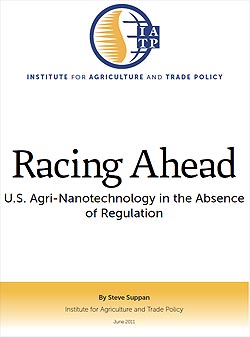 |
|
Lack Of Nanotechnology Regulation A Danger To Human Health, Environment
More than 1,300 products now on the market claim to incorporate Engineered Nanomaterials (ENMs), whose very tiny size yields novel properties, such as making products, lighter, stronger, and better able to retain moisture and deliver pesticides. None of these products have undergone a pre-market safety assessment. To prevent harm to public health and the environment, ENMs must be regulated and tested prior to commercial release, according to a report issued today by the Institute for Agriculture and Trade Policy (IATP).
 The report, “Racing Ahead: U.S. Agri-Nanotechnology in the Absence of Regulation,” takes into account a June 9 draft, voluntary guidance issued to industry regarding nanotechnology by the U.S. Environmental Protection Agency (EPA) and Food and Drug Administration (FDA)—released the same day as a White House–issued executive memorandum on principles of regulation and oversight of nanomaterials. The report, “Racing Ahead: U.S. Agri-Nanotechnology in the Absence of Regulation,” takes into account a June 9 draft, voluntary guidance issued to industry regarding nanotechnology by the U.S. Environmental Protection Agency (EPA) and Food and Drug Administration (FDA)—released the same day as a White House–issued executive memorandum on principles of regulation and oversight of nanomaterials.
The draft EPA guidance, if finalized, will take the first step towards requiring companies to submit ENM data for regulatory review.
Specifically addressing food and agriculture applications of nanotechnology—e.g., coating fruits and vegetables to preserve shelf life—the report details possible hazards to human health and the environment if they are marketed without pre-market safety assessment and post-market surveillance.
“While the guidance from these agencies is an encouraging first step, there is little motivation for companies using agri-nanotechnology to self-regulate,” said IATP’s Steve Suppan, senior policy analyst. “Many nanomaterial applications are classified as confidential business information, and those that are known have had little to no publicly available testing by regulatory authorities for human health, safety or environmental effects. We know from academic studies that ENMs present hazards that merit regulatory review.”
Several steps are needed to design and implement a nano-specific regulatory structure, including agreeing on a definition of what constitutes an ENM and developing a comprehensive inventory of which products are already in the market and which are in development.
Applications of ENMs include making toxins more bio-available in pesticides, targeting nutrients in smaller doses, improving the texture of ice cream and detecting bacteria in packaged foods. Under current rules, companies have the discretion to determine whether a substance already considered safe in its usual (macro-scale) form (and hence not reportable to the FDA) is also safe in its nano-scale form.
“As nanomaterials in internationally traded goods increases, administrative, technical and budgetary constraints are keeping U.S. and international agencies well behind the pace and variety of product commercialization,” author Steve Suppan said, “ Non-regulation and austerity budgets for regulators cannot comply with the White House memo order to protect human health, worker safety and the environment from ENM hazards.”
Download the entire report from the E-Library Database Choose category of Nano Technology.
Source: IATP
|
|
|
Designed, Hosted and Maintained by Union Safety Services
|


